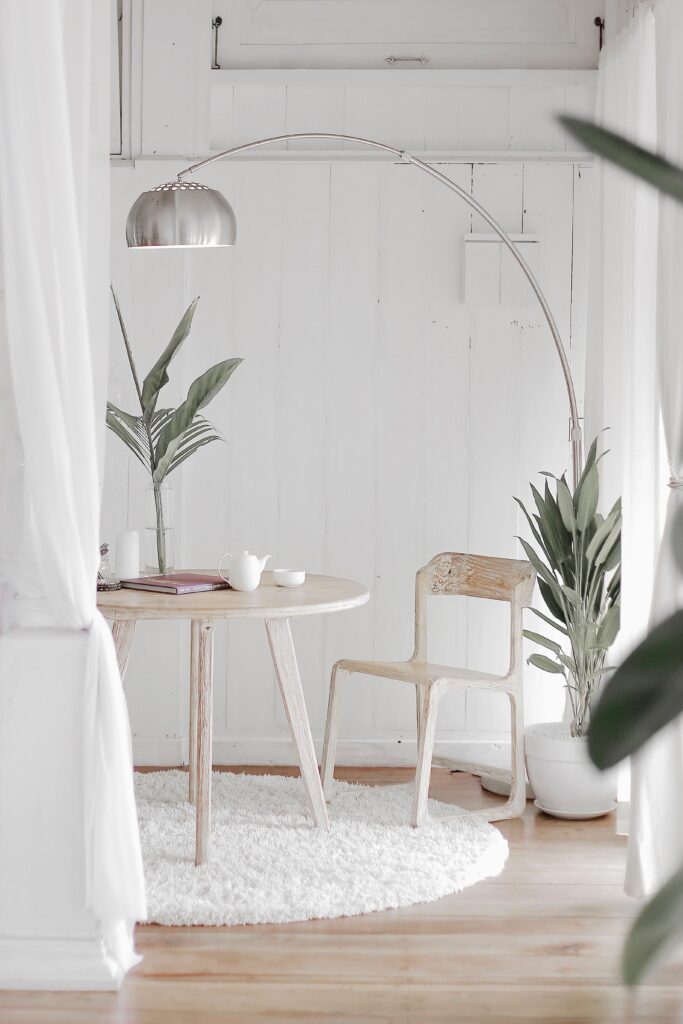At Interior Wala Sameer, we believe in creating beautiful spaces that not only cater to aesthetic and functional needs but also respect the environment. As sustainability becomes a global priority, eco-friendly interior design practices are becoming increasingly important. In this blog, we explore some of the most effective sustainable practices and materials that can transform your space while minimizing environmental impact.

Choosing eco-friendly materials is one of the easiest ways to incorporate sustainability into interior design. These materials are sourced responsibly, use fewer resources, and often come with a lower carbon footprint.

Bamboo is an incredibly sustainable material due to its rapid growth. It regenerates much faster than traditional hardwood trees, making it a perfect eco-friendly choice for flooring, furniture, and wall coverings. Bamboo is also durable and has a naturally beautiful finish.
Using reclaimed or recycled wood helps reduce the demand for new timber, preventing deforestation. This wood can be used in flooring, furniture, and wall panels, adding a rustic, timeless charm to interiors while reducing waste.
Cork is another renewable material that’s harvested from the bark of cork oak trees, which can regenerate over time. It’s lightweight, flexible, and serves as an excellent sound insulator, making it a versatile choice for flooring or even wall tiles.
Using recycled materials like metal and glass in furniture and decor is a sustainable practice that cuts down on the need for new raw materials. These can add a modern, industrial aesthetic to interiors without contributing to mining and other resource-depleting industries.

Traditional paints and finishes often contain volatile organic compounds (VOCs), which release harmful gases into the environment. Opting for low-VOC or zero-VOC paints significantly improves indoor air quality and reduces health risks for inhabitants. These paints come in a variety of colors and finishes, providing eco-friendly solutions without compromising on aesthetics.

Lighting accounts for a significant portion of energy use in any space. Incorporating energy-efficient lighting solutions, such as LED bulbs, not only reduces electricity consumption but also lowers utility bills. LED bulbs have a longer lifespan and are available in various designs that can complement different interior styles.
Additionally, designing spaces that maximize natural light helps reduce dependence on artificial lighting during the day. Installing larger windows or skylights can brighten up interiors and create a more energy-efficient environment.

Flooring is one of the largest surface areas in any interior, making it essential to choose eco-friendly options. Some sustainable flooring choices include:

Sustainable interior design isn’t just about the materials used—it’s also about how resources are conserved within the space. Water-efficient fixtures like low-flow faucets, dual-flush toilets, and energy-efficient dishwashers can significantly reduce water consumption. Incorporating water conservation into your design not only lowers utility bills but also helps protect a precious natural resource.

Upcycling refers to taking old or discarded items and transforming them into something new and functional. Whether it’s a vintage piece of furniture that’s been given a new life with eco-friendly paint or decor made from repurposed materials, upcycling reduces waste while creating one-of-a-kind pieces that add character to your space.

Incorporating plants into interior spaces has numerous environmental and health benefits. Plants act as natural air purifiers, absorbing toxins and producing oxygen. Vertical gardens, living walls, or simply placing potted plants around a room can enhance air quality and add a touch of nature to your design.
Opting for low-maintenance, drought-resistant plants like succulents or air-purifying plants like snake plants and peace lilies can be both sustainable and visually appealing.

Smart home systems can greatly improve energy efficiency in your interior spaces. Automated lighting systems, programmable thermostats, and smart plugs help reduce energy consumption by allowing homeowners to control and monitor energy use easily. These systems can be integrated seamlessly into any design, providing modern convenience with minimal environmental impact.

At Interior Wala Sameer, we are committed to creating spaces that are not only visually stunning but also environmentally responsible. Eco-friendly practices and materials in interior design are no longer a luxury but a necessity in today’s world. By choosing sustainable options, you can create a beautiful home or office that contributes to a healthier planet for future generations.
Incorporating these eco-friendly strategies into your next interior design project will help reduce environmental impact and create healthier, more sustainable living spaces.